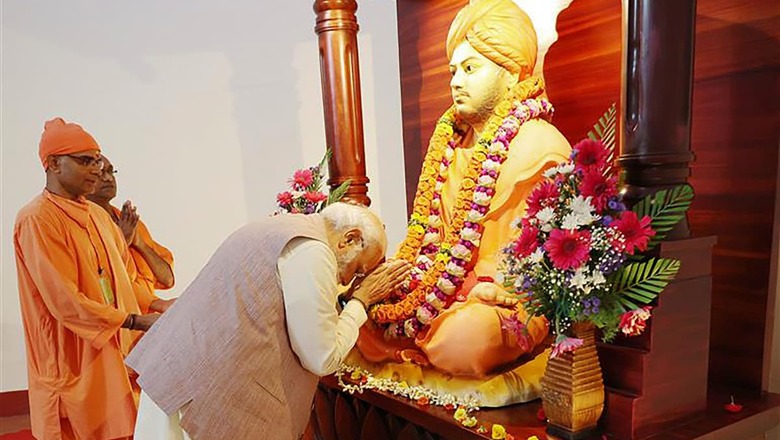
views
Swami Vivekananda (1863-1902) was a wandering sage whose heart was deeply captivated by the spiritual call of Varanasi. While he did not reside in Varanasi for an extended period, the mysticism that permeated this ancient city resonated profoundly with the great visionary, revered ascetic of India, and advocate for humanity. The experiences, knowledge, and wisdom he acquired during his visits to Varanasi remained an indelible part of his teachings throughout his life.
Varanasi’s spiritual heritage and hermitic traditions exerted an irresistible pull on Swami Vivekananda. As he embarked on his pilgrimage of self-discovery, following the Maha-Nirvana of his Guru, Swami Ramakrishna Paramahamsa, he always held Varanasi in high regard.
His initial visit to Varanasi occurred in 1890, during his itinerant phase before his historic appearance at the Parliament of the World’s Religions in Chicago in 1893. He returned to Varanasi once more in 1902, the same year he attained Mahasamadhi.
Volume 1 of the book written on the Great Swami titled The Life of Swami Vivekananda: By His Eastern and Western Disciples, published by the Advaita Ashrama, beautifully encapsulates his sentiments:
“Coming now to such details as we have of his extended pilgrimages, the first of these was Varanasi, the home of monks, the center of learning, and the Seat of Shiva. He set out from the Baranagore Math, accompanied by Premananda and Fakirbabu, a lay devotee of the Master. The sacred Ganga, the devout worshippers, the myriad temples, especially Vishwanath, Annapurna, and Durga, the sanctified atmosphere, and the awareness that it was here that Buddha and Shri Sankara had preached – all these left an indelible impression on him.”
Swami Vivekananda’s thought process for Varanasi is unmistakable in his writings. He regarded Varanasi as the holy city of Hinduism, the spiritual capital of India, and the eternal centre of Indian civilization.
In one of his letters, he expressed his desire to spend time in Varanasi, saying, “My idea is to remain there (Varanasi) for some time and to watch how Vishwanath and Annapurna deal it out to my lot. And my resolve is something like ‘either to lay down my life or realize my ideal’ – so help me, Lord of Kashi.”
The book says, “Often he would resolve to go to Varanasi and spend time in the sacred city of Vishwanath.”
During his pilgrimage through northern India in 1889 with his brother monks, he decided to go Varanasi, alone, adopting the name Swami Vividishananda. Here, the ascetic within him found kindred spirits during his stay at the Dwarkadas Ashrama. He engaged in profound discussions and meditations with scholars like Pandit and writer Bhudev Mukhopadhyay and the revered Saint Trailanga Swami, exploring spiritual questions and the deep mysteries of existence.
In 1902, after his second journey to the West, Swami Vivekananda returned to Varanasi again. By this time, he had transformed from an obscure monk into a globally renowned spiritual luminary and a source of pride for India. During this visit, he inspired young people to show selfless commitment to humanity.
Three young men, who considered Swamiji’s teaching as a life defining mantra, had started ‘Poor Men’s Relief Association’ in Varanasi in 1900. The association helped poor people get treatment at government hospitals or at a dispensary started by it. During his visit to the city two years later, Swamiji re-named the association as ‘The Ramakrishna Home of Service’ (Sevashrama).
Through this change, he emphasized the importance of selfless service to others as a means of manifesting the divine, highlighting the significance of genuine service over mere compassionate assistance. Today, Sevashrama is a big charitable association in the city with a modern 230-bed multidisciplinary hospital, popularly known to the public as Kaudia Hospital, to help needy people.
The OPD charges a nominal registration fee of just Rs 10 and that too is waived for very poor patients.




















Comments
0 comment